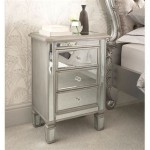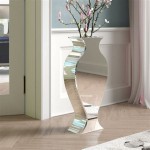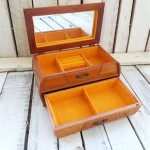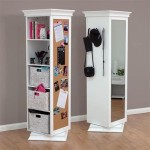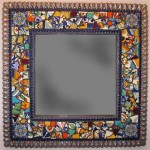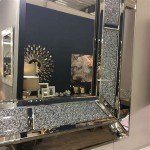What Glue to Use to Secure a Mirror to Wood
Adhering a mirror to a wooden surface requires careful consideration of the chosen adhesive. The longevity and stability of the bond depend heavily on selecting a glue that can withstand the specific conditions and materials involved. Factors such as the type of wood, the size and weight of the mirror, potential temperature fluctuations, and moisture exposure all influence the optimal adhesive choice. A failure to select the proper glue can result in the mirror detaching, potentially causing damage to the mirror itself, the wooden surface, and posing a safety hazard.
The primary challenges in gluing a mirror to wood stem from the different expansion and contraction rates of the two materials. Wood is porous and susceptible to changes in moisture content, leading to dimensional shifts. Mirrors, being glass, are relatively non-porous and exhibit minimal dimensional changes in response to humidity or temperature fluctuations. This disparity necessitates an adhesive that maintains its bond strength while accommodating these differential movements. Furthermore, some adhesives can react negatively with the silvered backing of the mirror, causing discoloration or degradation over time. Therefore, the adhesive must be chemically compatible with the mirror's reflective coating.
Selecting a Mirror-Compatible Adhesive
The paramount criterion for selecting an adhesive is its compatibility with the mirror's coating. Many construction adhesives contain solvents that can etch or dissolve the silver or aluminum backing. This etching not only mars the appearance of the mirror but also compromises its reflectivity and structural integrity. Look for adhesives explicitly labeled as "mirror mastic" or "mirror adhesive." These products are specifically formulated to be non-reactive with mirror coatings. They typically contain neutral pH formulas that will not cause corrosion or discoloration.
Before applying any adhesive to the entire mirror, it is crucial to conduct a spot test. Apply a small amount of the adhesive to an inconspicuous area of the mirror's backing, preferably near an edge that will be hidden. Allow the adhesive to cure completely according to the manufacturer's instructions. After curing, inspect the area for any signs of discoloration, etching, or degradation of the mirror's backing. If no adverse effects are observed, it is generally safe to proceed with applying the adhesive to the entire mirror. If any negative reactions are noticed, immediately discontinue use of that adhesive and seek an alternative.
In addition to compatibility, consider the adhesive's flexibility. Rigid adhesives may crack or lose their bond when subjected to the stresses caused by the differing expansion and contraction rates of wood and glass. A flexible adhesive can absorb these stresses and maintain a secure bond over time. Many mirror mastics are formulated with a degree of elasticity to accommodate these movements. Reading the product specifications and technical data sheets will reveal the adhesive's flexibility characteristics.
Preparing the Wood and Mirror Surfaces
Proper surface preparation is essential for achieving a strong and durable bond. Both the wood and the mirror's backing must be clean, dry, and free of any loose debris, dust, grease, or other contaminants. On the wooden surface, start by sanding the area to be bonded with medium-grit sandpaper (e.g., 120-grit) to create a slightly roughened surface. This roughening increases the surface area available for bonding and provides a better mechanical key for the adhesive. After sanding, remove all sanding dust with a clean, dry cloth or a vacuum cleaner. If the wood is painted or varnished, ensure the coating is sound and well-adhered. Loose or flaking paint should be removed before applying the adhesive.
The mirror's backing requires equally meticulous cleaning. Use a soft, lint-free cloth dampened with isopropyl alcohol to remove any fingerprints, dust, or residue. Avoid using harsh cleaners or abrasive materials, as these can damage the protective coating on the mirror's backing. Allow the alcohol to evaporate completely before applying the adhesive. A clean, dry surface is crucial for optimal adhesion. In some cases, particularly with older mirrors, the backing may have deteriorated. Loose or flaking sections of the backing should be carefully removed before gluing. A primer specifically designed for mirror backing can be applied to improve adhesion to the remaining coating.
In situations where the wood is particularly porous or absorbent, applying a primer or sealant to the wood surface before applying the adhesive can improve the bond strength. A primer helps to reduce the absorption of the adhesive into the wood, ensuring that sufficient adhesive remains on the surface to form a strong bond with the mirror. Choose a primer that is compatible with both the wood and the chosen adhesive. Follow the manufacturer's instructions for applying the primer and allow it to dry completely before proceeding with the adhesive application.
Applying the Adhesive and Supporting the Mirror
The method of applying the adhesive is critical for achieving a uniform and secure bond. Mirror mastics are typically applied in vertical beads across the back of the mirror. The spacing between the beads depends on the size and weight of the mirror, but generally, beads should be spaced approximately 4 to 6 inches apart. Avoid applying adhesive to the very edges of the mirror, as this can create a visible squeeze-out when the mirror is pressed against the wood. The amount of adhesive should be sufficient to provide a solid bond but not so excessive that it oozes out and creates a mess.
After applying the adhesive, carefully position the mirror onto the prepared wooden surface. Press the mirror firmly against the wood, ensuring that the adhesive makes full contact with both surfaces. Apply even pressure across the entire surface of the mirror to ensure a uniform bond. Avoid sliding the mirror after it has made contact with the adhesive, as this can disrupt the adhesive layer and weaken the bond.
Providing temporary support for the mirror while the adhesive cures is essential to prevent it from shifting or falling. Use clamps, braces, or strong adhesive tape to hold the mirror in place. The type of support will depend on the size and orientation of the mirror, as well as the configuration of the wooden surface. For smaller mirrors, painter's tape may suffice to hold the mirror in place. For larger mirrors, more substantial clamps or braces may be necessary. Leave the supports in place for the duration of the adhesive's curing time, as specified by the manufacturer. Premature removal of the supports can compromise the bond strength and lead to failure.
The environmental conditions during the curing process can also affect the bond strength. Avoid exposing the mirror to extreme temperatures or humidity levels while the adhesive is curing. Ideally, the mirror should be allowed to cure in a stable environment with moderate temperature and humidity. Check the adhesive manufacturer's instructions for specific recommendations regarding curing temperature and humidity. Proper curing is crucial for achieving the maximum bond strength and ensuring the long-term stability of the mirror installation.
In summary, successfully securing a mirror to wood involves careful selection of a mirror-compatible adhesive, meticulous surface preparation, proper application of the adhesive, and adequate support during the curing process. Choosing the right adhesive is paramount, as many common adhesives can damage the mirror's backing. Thorough cleaning and preparation of both surfaces are essential for optimal adhesion. Applying the adhesive in a uniform manner and providing temporary support until the adhesive is fully cured will ensure a strong and durable bond that lasts for years to come.

4 Easy Steps To Glue Mirror Wood

How To Glue A Mirror Wood Fast Effective Start Woodworking Now

How To Frame A Mirror With Clips Glue The Wall

How To Glue A Heavy Mirror The Wall Mom Blog Society

How To Make A Diy Wood Frame Mirror With Mirrors Tea And Forget Me Nots

How To Glue A Mirror Wood Fast Effective Start Woodworking Now

Diy Farmhouse Mirror Made From Shims House Of Hepworths

How To Use Mirror Adhesive Silicone
Mirror Adhesive Adiseal Strong Glue For

Easy Driftwood Mirror The Wood Grain Cottage

